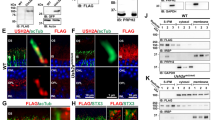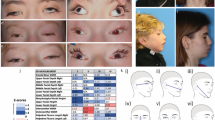Abstract
USHER syndrome represents the association of a hearing impairment with retinitis pigmentosa1 and is the most frequent cause of deaf–blindness in humans. It is inherited as an autosomal recessive trait which is clinically and genetically heterogeneous2,3. Some patients show abnormal organization of microtubules in the axoneme of their photoreceptors cells (connecting cilium)4–6, nasal ciliar cells7 and sperm cells5, as well as widespread degeneration of the organ of Corti8. Usher syndrome type 1 (USH1) is characterized by a profound congenital sensorineural hearing loss, constant vestibular dysfunction and prepubertal onset of retinitis pigmentosa. Of three different genes responsible for USH19–11,USH1B maps to 11q13.5 (ref. 10) and accounts for about 75% of USH1 patients2,3. The mouse deafness shaker-1 (shl) mutation has been localized to the homologous murine region12,13. Taking into account the cytoskeletal abnormalities in USH patients, the identification of a gene encoding an unconventional myosin as a candidate for shaker-1(ref. 14) led us to consider the human homo-logue as a good candidate for the gene that is defective in USH1B. Here we present evidence that a gene encoding myosin VIIA is responsible for USH1B. Two different premature stop codons, a six-base-pair deletion and two different missense mutations were detected in five unrelated families. In one of these families, the mutations were identified in both alleles. These mutations, which are located at the amino-terminal end of the motor domain of the protein, are likely to result in the absence of a functional protein. Thus USH IB appears as a primary cytoskeletal protein defect. These results implicate the genes encoding other unconventional myosins and their interacting proteins as candidates for other genetic forms of Usher syndrome.
Similar content being viewed by others
References
Usher, C. R. Lond. Ophthal. Hosp. Rep. 19, 130–236 (1913/14).
Smith, R. J. H. et al. Am. J. med. Genet. 50, 32–38 (1994).
Larget-Piet, D. et al. Genomics 21, 138–143 (1994).
Barrong, S. D. et al. Arch. Ophthalmol. 110, 706–710 (1982).
Hunter, D. G., Fishman, G. A., Metha, R. S. & Kretzer, F. L. Arch. Ophtalmol. 104, 385–389 (1986).
Bonneau, D. et al. J. med. Genet. 30, 253–254 (1993).
Arden, G. B. & Fox, B. Nature 279, 534–536 (1979).
Shinkawa, H. & Nadol, J. B. Ann. Otol. Rhinol. Laryngol. 95, 313–318 (1986).
Kaplan, J. et al. Genomics 14, 979–987 (1992).
Kimberling, W. J. et al. Genomics 14, 988–994 (1992).
Smith, R. J. H. et al. Genomics 14, 995–1002 (1992).
Evans, K. L. et al. Hum. molec. Genet. 2, 115–118 (1993).
Brown, K. A., Sutcliffe, M. J., Steel, K. P. & Brown, S. D. M. Genomics 13, 189–193 (1992).
Gibson, F. et al. Nature 374, 62–64 (1995).
Guilford, P. et al. Hum. molec. Genet. 3, 989–993 (1994).
Bement, W. M. et al. Proc. natn. Acad. Sci. USA. 91, 6549–6553 (1994).
Rayment, I. et al. Science 261, 50–58 (1993).
Steel, K. P. & Brown, S. D. M. Trends genet. Sci. 10, 428–435 (1994).
Brown, S. D. M. & Steel, K. P. Hum. molec. Genet. 3, 1453–1456 (1994).
Adams, R. J. & Pollard, T. D. Cell Motil. Cytoskel. 14, 178–182 (1989).
Cheney, R. E., Riley, M. A. & Mooseker, M. S. Cell Motil. Cytoskel. 24, 215–223 (1993).
Williams, D. S., Hallett, M. A. & Arikawa, K. J. Cell Sci. 103, 183–190 (1992).
Tilney, L. G., Tilney, S. M. & DeRosier, D. J. A. Rev. Cell Biol. 8, 257–274 (1992).
Piperno, G., Ramanis, Z., Smith, E. F. & Sale, W. S. J. Cell Biol. 110, 379–389 (1990).
Jaeger, R. G., Fex, J. & Kachar, B. Hearing Res. 77, 207–215 (1994).
Colluccio, L. M. & Bretcher, A. J. Cell Biol. 108, 495–502 (1989).
Assad, J. A. & Corey, D. P. J. Neurosci. 12, 3291–3309 (1992).
Gillespie, P. G., Wagner, M. C. & Hudspeth, A. J. Neuron 11, 581–594 (1993).
Metclaf, A. B., Chelliah, Y. & Hudspeth, A. J. Proc. natn. Acad. Sci. U.S.A. 91, 11821–11825 (1994).
Pollard, T. D., Doberstein, S. K. & Zot, H. G. A. Rev. Physiol. 53, 653–681 (1991).
Mercer, J. A. et al. Nature 349, 709–712 (1991).
Author information
Authors and Affiliations
Rights and permissions
About this article
Cite this article
Well, D., Blanchard, S., Kaplan, J. et al. Defective myosin VIIA gene responsible for Usher syndrome type IB. Nature 374, 60–61 (1995). https://doi.org/10.1038/374060a0
Received:
Accepted:
Issue Date:
DOI: https://doi.org/10.1038/374060a0
- Springer Nature Limited
This article is cited by
-
Genetics, pathogenesis and therapeutic developments for Usher syndrome type 2
Human Genetics (2022)
-
The genetic and phenotypic landscapes of Usher syndrome: from disease mechanisms to a new classification
Human Genetics (2022)
-
Usher syndrome type IV: clinically and molecularly confirmed by novel ARSG variants
Human Genetics (2022)
-
A binding protein regulates myosin-7a dimerization and actin bundle assembly
Nature Communications (2021)
-
How Zebrafish Can Drive the Future of Genetic-based Hearing and Balance Research
Journal of the Association for Research in Otolaryngology (2021)





